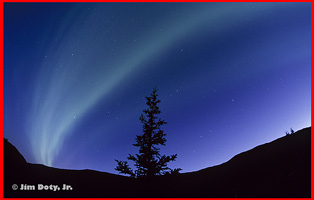
 |
 |
|||
|
Photographing Auroras |
|||
|
The Northern Lights aren't that hard to photograph. The challenge is to be out when they are out, with clear dark skys and a nice skyline. The technique is simple: wide-angle, fast aperture lenses, fast films, tripod, and cable release or electronic remote. I prefer single focal length, fast aperture lenses but you can use a wide angle zoom. My favorite lenses are a 24mm f/2.8 and 15mm f/2.8. Wide angle lenses show more of the aurora as they sweep across the sky. Stopping down an f/2.8 lens to f/4 gives sharper star images in the corners of the frame. If you are using a zoom lens with an f/4 maximum aperture, go ahead and use it at f/4. Slide film is preferable to negative film (unless you do your own printing or have a good lab that will work with you on the quality of the final prints). With slide film, the results of your work are clear. I like Kodak E200 pushed one or two stops, giving effective film speeds of 320 and 640 respectively. The amateur version, Kodak Elite Chrome 200, will work fine also. Put your camera and lens on a tripod. Compose to include both the aurora and the skyline (if it is interesting). Set your aperture at f/4. Focus the lens on infinity (be careful with zooms that focus past infinity), and begin taking exposures anywhere from 8 seconds to 1 minute. Use the camera's self timer, or a cable release or electronic remote so you don't jar the camera during the exposure. The best exposure times depend a lot on the varying brightness of the aurora. Check out the N Lights photos in the Alaska section. |
|
October 25, 2000 |
|
Copyright © Jim Doty, Jr. All rights reserved. |
|
|
|
||||||||||||||||||||||||